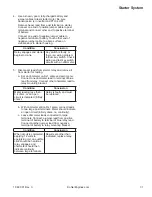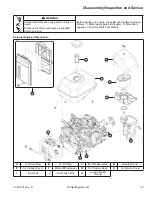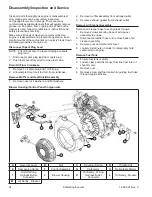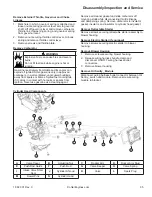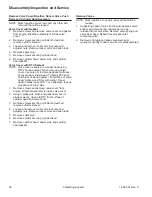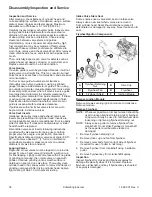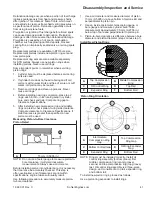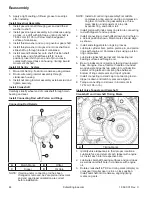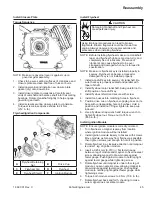
30
Starter System
KohlerEngines.com
18 690 01 Rev. C
NOTE: Do not crank engine continuously for more than 10 seconds. Allow a 60 second cool down period between
starting attempts. Failure to follow these guidelines can burn out starter motor.
NOTE: If engine develops suf
fi
cient speed to disengage starter but does not keep running (a false start), engine
rotation must be allowed to come to a complete stop before attempting to restart engine. If starter is engages
while
fl
ywheel is rotating, starter pinion and
fl
ywheel ring gear may clash, resulting in damage of starter.
NOTE: If starter does not crank engine, shut off starter immediately. Check condition of inline fuse and do not make
further attempts to start engine until condition is corrected.
NOTE: Do not drop starter or strike starter housing. Doing so can damage starter.
Engines in this series use inertia drive electric starters or retractable starters. Inertia drive electric starters are not
serviceable.
Troubleshooting-Starting Dif
fi
culties
Condition
Possible Cause
Conclusion
Starter does not energize.
Battery
Check speci
fi
c gravity of battery. If low, recharge or replace
battery as necessary.
Wiring
Check fuse condition.
Clean corroded connections and tighten loose connections.
Replace wires in poor condition and with frayed or broken
insulation.
Starter Switch
or Solenoid
Check switch or relay operation. If starter cranks normally,
replace faulty components.
Starter energizes but turns
slowly.
Battery
Check speci
fi
c gravity of battery. If low, recharge or replace
battery as necessary.
Wiring
Check for corroded connections, poor ground connection.
Transmission
or
Engine
Make sure clutch or transmission is disengaged or placed
in neutral. This is especially important on equipment with
hydrostatic drive. Transmission must be exactly in neutral to
prevent resistance which could keep engine from starting.
Check for seized engine components such as bearings,
connecting rod, and piston.
Electric Starting System Tests
1. Test battery on unit.
a. Connect a DC voltmeter across battery terminals
and read battery voltage (key switch OFF).
b. Turn key switch to start position and read battery
voltage again. Turn switch OFF.
Condition
Conclusion
Voltage less than 12 volts. Charge battery.
Battery voltage should not
fall below 9 volts during
cranking.
If it does, battery may be
faulty or there may be a
short in starting circuit.
Have battery load tested.
If battery passes load test,
check circuitry.
2. Remove electric starter cover panel and check fuse
inside plastic holder. Fuse outside holder is a spare.
Condition
Conclusion
Fuse is blown.
Check for a wiring
problem (bare wire, short
circuit). Correct problem
and replace fuse. Try to
start engine. If it still won’t
start, go to step 3.
3. Disconnect blue relay lead. Be sure transmission is
in neutral and PTO is OFF. Connect one end of a
jumper lead to positive terminal of battery. Connect
other end to terminal of relay.
Condition
Conclusion
Relay engages and starter
begins to crank.
Key switch is faulty, or
there is a wiring problem
to/from key switch. Check
wiring and test key switch
circuits with an ohmmeter.
Summary of Contents for T27710
Page 40: ...38 Model T27710 Mfd Since 04 16...
Page 44: ......
Page 45: ......
Page 46: ......
Page 47: ......
Page 48: ......
Page 49: ......
Page 50: ......
Page 51: ......
Page 52: ......
Page 53: ......
Page 54: ......
Page 55: ......
Page 56: ......
Page 57: ......
Page 58: ......
Page 59: ......
Page 60: ......
Page 61: ......
Page 62: ......
Page 115: ...53 18 690 01 Rev C KohlerEngines com...
Page 116: ...54 KohlerEngines com 18 690 01 Rev C...
Page 117: ...55 18 690 01 Rev C KohlerEngines com...
Page 118: ...56 KohlerEngines com 18 690 01 Rev C 2015 by Kohler Co All rights reserved...
















